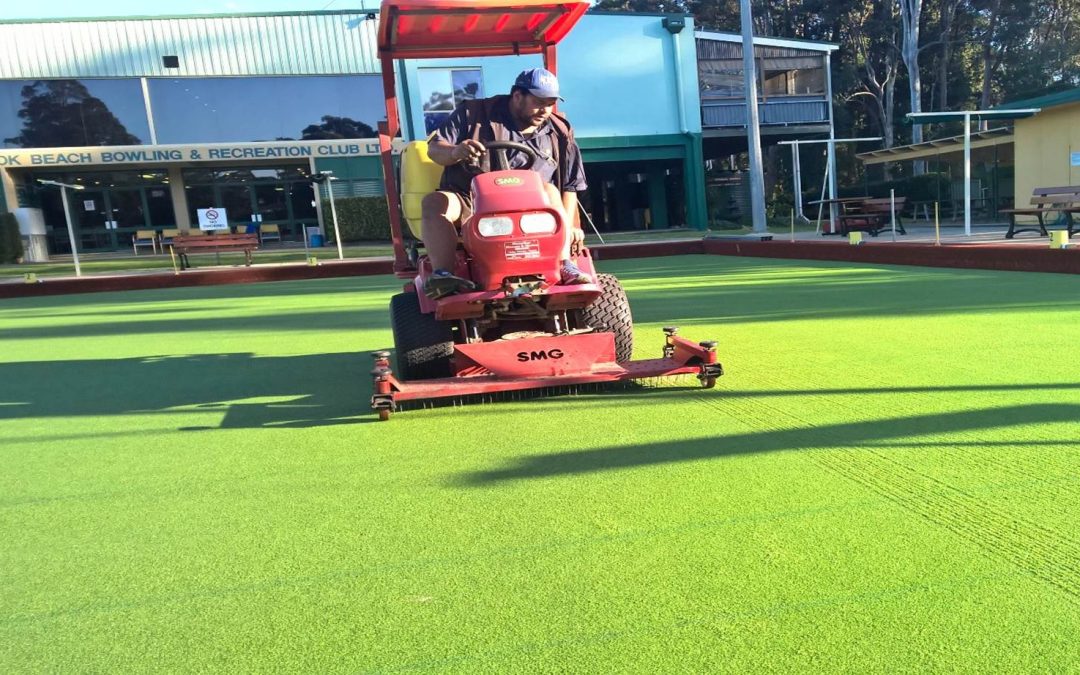The long spell of extremely wet weather across Sydney and the East Coast of NSW throughout 2021/22 reinforced one of the key advantages of synthetic grass bowling greens – their resilience. As natural greens became boggy and unplayable, player usage on synthetic grass bowling greens increased ensuring Clubs were able to continue their competitions and social bowling programmes thus enabling them to maintain their revenue streams.
The challenge for Club Green Keepers was to ensure that greens continued to perform at peak levels under this increased demand while satisfying their Bowler’s expectations, which can be understandably high! Sports Clean provided onsite guidance and advice for several Clubs during this period. And in all cases both the synthetic grass bowling greens and Green Keepers rose to the challenge.
But we also regularly inspect sites where there is confusion around the brushing and rolling regime required for ongoing synthetic grass bowling green maintenance. While installers of synthetic grass greens provide post installation grooming/brushing instructions for a ‘settling down period’, further clarification is required on grooming & brushing for a standard maintenance programme for the long term. This is also ultimately determined based on green usage levels and the climatic conditions of the location.
There are several different brushing and grooming machines available on the market for Clubs to purchase and use in their maintenance programme. Natural grass mowers can also be re- configured which provide a cost-effective option where Clubs have already outlaid considerable capital to upgrade their greens.
The objective of routine grooming and brushing maintenance of synthetic grass bowling greens (and all filled synthetic grass sports surfaces) is to brush pile up and keep kiln dried sand infill loose, clean and even.
We generally advise Green Keepers to never use a brooming/brushing machine that rolls and flattens the pile. If pile is permanently flattened it cannot be stood up again and will change the playing characteristics of the bowling green and significantly reduce its life span.
Our general recommendation is to use an appropriate machine (check with the green installer) to brush the green every week/fortnight (frequency depends on usage), over the entire surface in all directions (North/South, East/West, and diagonally). Note: be careful that machine brushes are lifted out of the pile when turning or stopping and do not cross seams at 90 degrees.
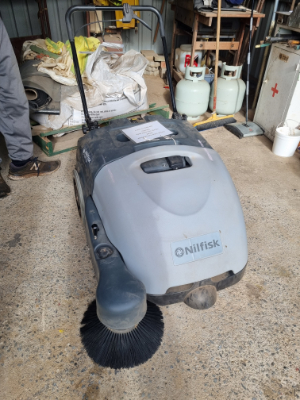
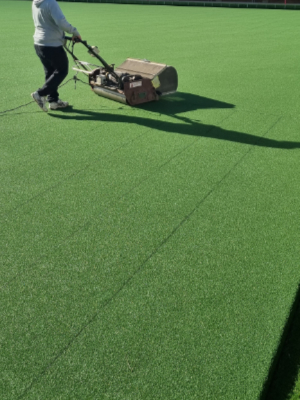
Running machines diagonally across the bowling green
In addition to machine work it is also a good time to review other maintenance tasks that Clubs and Green Keepers can undertake inhouse. Diligence in completing these tasks will maximise the surface performance. This will enhance the Bowler playing experience and ensure the surface lasts for its expected lifespan.
This will also guarantee the Club receives a good return on their financial investment.
Recommended Inhouse Maintenance Tasks
To be completed as often as necessary
Always refer to the Maintenance Instructions of the Field Manufacturer and Installer as a first reference point. The following is a general guide only……
- Remove any loose debris with a rake or a vegetation sweeper, never a blower (a blower will move the sand around and make it uneven).
- Water the green (if permissible to do so) before play on the main Club playing days to achieve desired bowls speeds.
- Keep the ditches free of debris.
- Keep the surface free of algae and moss infestations – surfaces can be slippery where these take ‘hold’.
- Rotate rinks regularly to protect high traffic areas.
- Hand broom heavy traffic areas to brush up the pile using a hard bristle boom.
- Provide suitable matting where the bowlers enter the green to prevent dirt/mud/grass being carried onto the surface on shoes.
- Any animal/bird droppings to be addressed immediately as stains can be difficult to remove. Consider using a sanitiser (check with the installer before proceeding).
- Budget for and Schedule regular Deep Clean Major Services with a specialist maintenance provider.
- Address any seam repairs or damage caused by cockatoo attacks immediately by calling in a specialise maintenance provider.
Keep rink line marks topped up and clear for player usage.

Markers for rink rotation.
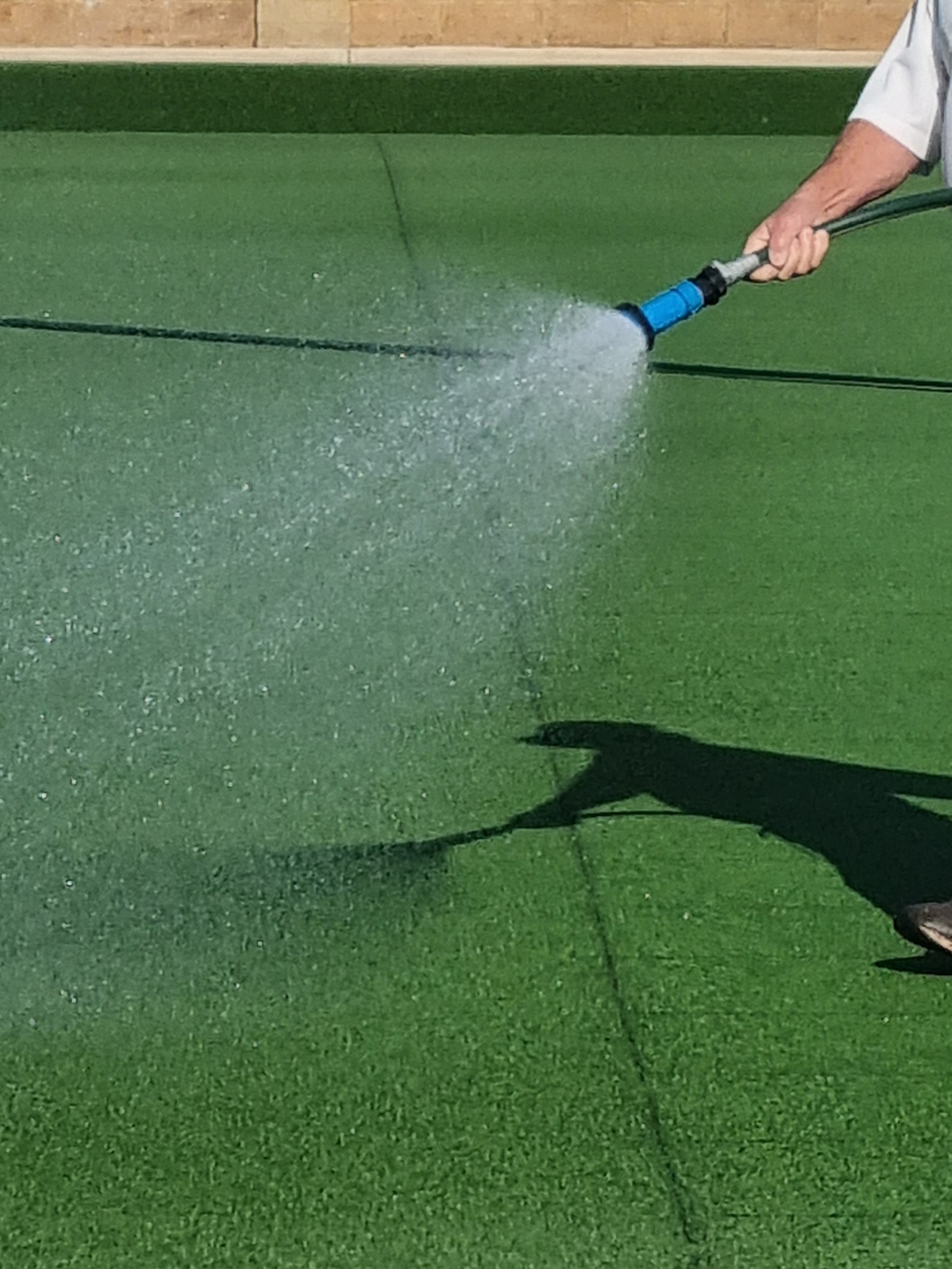
Watering the bowling green post brushing and grooming to ensure desired bowls speeds are reached.
Check Your Onsite Maintenance Toolbox
- Regularly check/service any grooming/brushing machines that are used on the bowling green to ensure brush/groom settings are correct and effective.
- Check there are no machine leaks that could cause staining on the synthetic grass surface.
- Invest in smaller items like a hand broom for brushing up pile in heavy wear areas.
- Another good investment is a leaf/debris collecting drag mat (no blowers).
How Sports Clean Adds Value To Bowling Green Maintenance
Sports Clean has nearly 25 years’ experience in the maintenance of synthetic sports surfaces. We work to develop ongoing relationships with Bowls Club CEO’s and Committees seeking to add value through our expertise in the maintenance industry. The experience and knowledge of our Key Personnel is unmatched in Australia, we own a fleet of SMG Maintenance Equipment available for different types of field servicing and we prioritise communication between key facility stakeholders.
Professional Services Deep Clean Servicing
In addition to the steps above, outside Professional Field Maintenance Providers need to be engaged for Deep Clean Field Servicing. Based on usage, in-house maintenance, climatic conditions and Club budgets, Sports Clean recommends a minimum of 2 x Deep Clean Services per year. The SMG Sport Champ, with its various attachments, is used by Sports Clean for Major Services. A Service Report is provided to the Client following each service identifying maintenance areas of concern for Clubs. This is particularly important as greens age.
Bowling Green Rejuvenation Service
From time to time the Bowling Green will require a Rejuvenation/Decompaction Service.
A Bowling Green surface is designed to be very level, with no falls in any direction. Hence the lateral water runoff is minimal except in heavy rain. As a result, general pollution from the air and from usage does not get washed off the surface but sits on top. This pollution works its way down into the pile hindering the designed green drainage through the carpet into the free draining base below.
Over time these drainage impediments need to be disturbed, and where possible, extracted from the green by way of very heavy decompaction. A decompaction services uses steel tines to loosen the surface. See the photo which demonstrates the impact on the green surface.
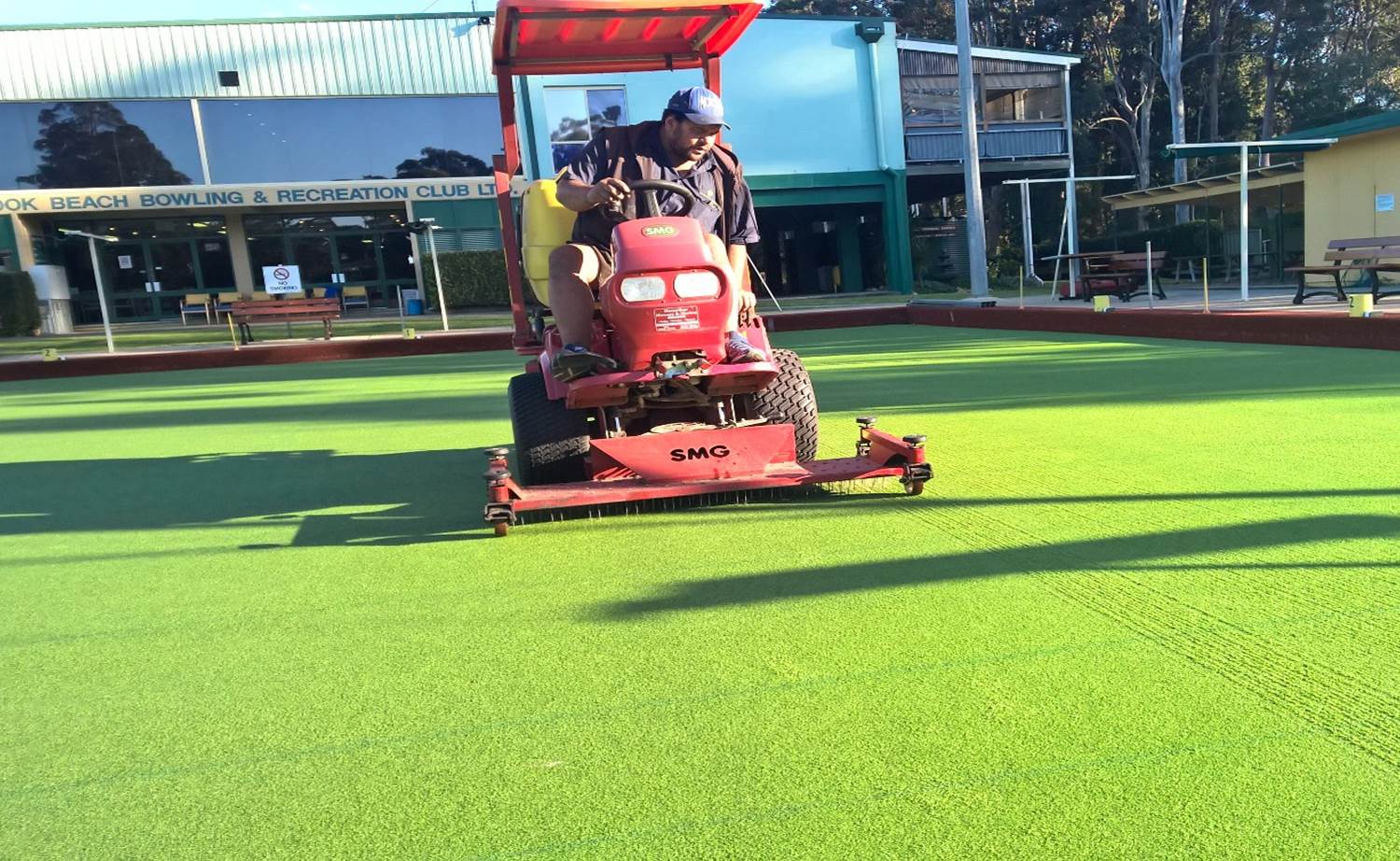
This loosening allows for brushing, vacuum extraction, and filtration of the surface infill. This is a time-consuming process taking approximately one full day on site. Deeper down impediments are loosened by the process but not extracted and will ‘float out’ following the decompaction Service, particularly when it rains.
As a Synthetic Bowling Green ages and the infill becomes dirtier, the need for this planned process will become more frequent, perhaps every 2 years.
There is a range of online resources that can be easily accessed via our website https://sportsclean.com.au/bowling/
And an online shop for maintenance equipment and supplies like algaecide spray:
https://sportsclean.com.au/shop/
For further information or expert advice on synthetic bowling green maintenance, please contact Sports Clean on info@sportsclean.com.au or call 02 9420 1200.
Photos: We thank the Members of the Two Wells Bowling Club for allowing photos to be taken for this Blog.

